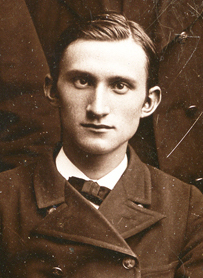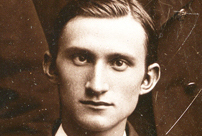Ferdinand Christian Peter Ohrt
In the Kalevala theme issue of the journal Valvoja in 1909 there was a presentation of contemporary translators who had made the Kalevala accessible in their own language regions. The Finnish people often also benefited of the background research for the translations. This is pointed out in the following text by the folklorist, professor E. N. Setälä.
“F. Ohrt, who was a teacher at the Sorö school, was the editor of the Danish Kalevala that was created according to the poetic meter. He had published a few samples earlier and the year before, he had published a translation of the Kalevala in the format of a whole book, but which, at the same time, contains only a selection of about 10 000 of the 23 000 verses of the Kalevala. The translation is done by using the original poetic meter, however, freely; the end rhymes have not been directly translated, but the translator has, neither, tried to avoid them. The translation is, all in all, very pleasurable; the translator has probably made a good decision as he is giving the audience a selection of the poems instead of the whole Kalevala.
However, the translator has not only published a translation. He also gives the Danish readers a presentation of the Kalevala, the history of its origin as a whole, and also of the origin of its parts, the occurrence of themes connected with folk poetry in literature, both in literature in the Finnish and Swedish languages, in foreign literature, as well as in fine art. This presentation is a complete volume and its title is »Kalevala som Folkedigtning og National-Epos» (in English: The Kalevala as folk poetry and national epic) and it is based on all available sources – the author knows and speaks the Finnish language quite fluently – and it is done with great knowledge of how to make the selection as well as of our folk poetry. There does not exist any equally great general overview of our research findings on our folk poetry, not even in our own country. As odd as it may seem, we have to borrow the general overview from Denmark; the book by F. Orth is soon to be published translated into Finnish. It is worth mentioning that both parts of F. Orth’s Kalevala have been published with the financial support of the Carlsberg Foundation.”
Apparently, the Finnish translation of Orth’s book was already at the printing company since the book Kalevala kansanrunoelmana ja kansalliseepoksena (in English: The Kalevala as a folk poem and a national epic) came out the same year, in 1909. It was translated by Jaakko Suomalainen and proofread by Kaarle Krohn.
In the same issue of the Valvoja, Ferdinand Christian Peter Ohrt introduces himself as follows:
My Finnish studies

Ferdinand Christian Peter Ohrt (1873–1938)
“I was born in the Danish speaking part of North Schleswig-Holstein in 1873. I have graduated with bachelor’s and master’s degrees in theology (cand. theologiae et magisterii) from the University of Copenhagen (and I have also a degree in university pedagogics, with Danish and history as my majors). I have worked as a teacher in the Sorö school and reformatory since 1902.
The first time I got acquainted with the Finnish language was during the same year that I graduated from high school; when I was a student at that school, where I am now a teacher, I happened to come across (a very bad) Finnish-German introductory textbook and I started immediately to study its contents — partly because learning languages was my hobby and partly because I had already as a child read Topelius and I had fallen for Finland. That same autumn — when I had graduated — I borrowed the only Finnish text on the Kalevala from the university library, which I could find there (at least at that point of time): It was the first 10 poems published by Ahlqvist (there was a Finnish-Swedish glossary in the book). While I was reading the book, even though it was difficult, I was so charmed by it that after I had read it, I acquired and read the Swedish translation by Collan; however, it took me 10 years to read the whole Kalevala in Finnish.
My own research work took so much of my time that I did not learn much Finnish during the years of my university studies (not even when I travelled to Vyborg and Punkaharju for a couple of weeks). Not until recent years (after 1902) have I both read a lot in Finnish and also had some practical training in the Finnish language (in 1905 I spent 2 months in the Takaharju sanatorium, in 1906 I visited prof. Krohn and travelled to Suistamo and Akonlahti to listen to folk singers; here in Denmark I have only sporadically had the opportunity to speak Finnish).”
Valvoja, 01.01.1909, nr 3, pages 123–125.
